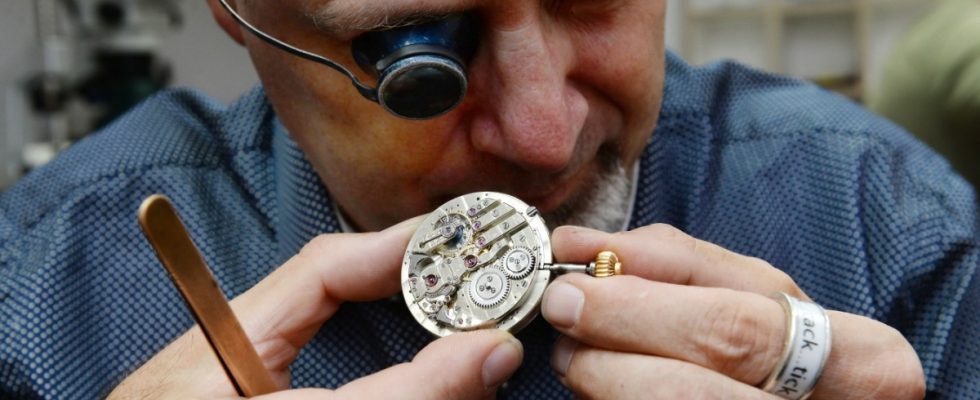The magnifying glass clamped in front of his right eye, the tweezers between thumb and forefinger, Andreas Fritsch bends over the work table. Carefully grabs a tiny wheel from the table and puts it in the right place in the opened pocket watch. His hand will perform this movement a total of around 200 times, because the noble piece from the 19th century has so many parts. A family heirloom entrusted to him by a customer to be repaired. “Disassembling is obviously easier than reassembling,” says Fritsch and laughs.
But the watchmaker knows exactly what goes where. His hand isn’t exactly filigree, a beautiful, strong man’s hand – it’s hard to believe how he does such difficult work with it. With a sure grip, he puts cogs, springs and tiny waves together. Use a miniature screwdriver to tighten screws smaller than a poppy seed. Use the tweezers to put the “escapement” and the “hour scale” in place. The escapement is a small gripping arm that slides into the twelve prongs of the sawn-out hour scale. The teeth are ground to a tenth of a millimeter and cannot be seen with the naked eye. But it depends on them so that the clock shows the exact hours.
Isn’t that incredibly exhausting? “Oh,” says Fritsch, “you get used to it.” The watchmaker is a happy person. When he takes off the magnifying glass, he puts on his colorful glasses so that he can see the surroundings clearly. His goatee is neatly trimmed, and laugh lines surround his eyes. He loves his job, you can tell after a few minutes. And he likes to talk about it.
He is in demand as a watch expert on “Kunst und Krempel” on Bavarian television. He gives watch seminars in his workshop near the Deutsches Museum in Munich. There, customers can assemble their own wristwatch under his guidance.
Above all, you need a steady hand. And patience.
What makes a good watchmaker? Contrary to what was expected, Fritsch answers modestly at first: “We have machines here for everything.” Because in contrast to most other companies, the craftsman produces almost all the parts he needs himself. Hands and cogs, pins and hour scales. But anyone can put machines in the workshop. Of course, what you need most of all is a steady hand. And patience.
Andrew Fritsch.
(Photo: Robert Haas)
Andreas Fritsch, born in Munich in 1968, is one of those rare people who already knew as a child what they wanted to be when they grew up. His father, who is a veterinary surgeon, once disassembled and reassembled grandpa’s old cuckoo clock before his eyes. “I found that fascinating,” says Fritsch. Watchmaker, that’s it, thought the twelve-year-old at the time. An internship in the eighth grade confirmed his decision. After the master’s examination, he then went to Switzerland for two years, to the renowned International Watch Museum in La Chaux-de-Fonds, where he received further training as a restorer of antique watches. He started his own business more than 20 years ago. Since then, restoring valuable old watches has been his specialty.
Whether it’s a wall clock with a pendulum, a table clock with gilded rococo putti or a pocket watch with a tiny striking mechanism – no order is too complicated for Fritsch. He wants to get the clocks running again. For him, the noble pieces are not just timepieces. “It’s true that without the invention of the clock, our industrialization would have been impossible,” he says. Above all, Fritsch is enthusiastic about the aesthetics of craftsmanship in earlier times.
He opens the case of a pocket watch from 1880. The bearings are made of tiny rubies. “And look: everything is polished,” says Fritsch. “That wouldn’t have been necessary. But the watchmaker back then wanted it to shine and meet the highest standards. He immortalized his own signature in every piece.”
Only with a magnifying glass can you see the fine work that someone did more than 150 years ago. The craftsman may have spent well over 100 hours on the decoration alone. Back then, time wasn’t as much money as it is today. Even the tiny cogs are still quilted. “Nobody sees it from the outside,” says Fritsch, “but we know it, and so do our customers.”
The palms.
(Photo: Robert Haas)
The hands of master watchmaker Andreas Fritsch.
(Photo: Robert Haas)
Beauty has its price. The restoration of such a pocket watch will definitely cost several thousand euros, depending on how much effort is involved. But if a customer requests it, Andreas Fritsch will of course also grind beautiful patterns into the metal, as long as it corresponds to the original. And of course he polishes the parts he makes himself. When it comes to finishing, he says, i.e. the final touch before all the parts are fixed and the case is closed again, “that’s where the hand really comes into play.” In any case, Fritsch himself is always pleased with the beauty that such an antique clockwork represents. Before a customer picks up their precious piece, it is placed on the timing machine. It is electronic and measures the vibrations. Deviations of tenths of a second come to light. So precision is everything in this craft.
His pride and joy is in the window of Fritsch’s workshop: “Le cercle”, a room clock he designed and built himself. Glass cylinder, fixed hands, rotating numeral rings made of ceramic; gold-plated clockwork and striking hammer. This watch really has its own signature.
Everyone needs their head to work in their job. Some also require very special manual dexterity. In our new series, we introduce people in Munich who do special manual work.

